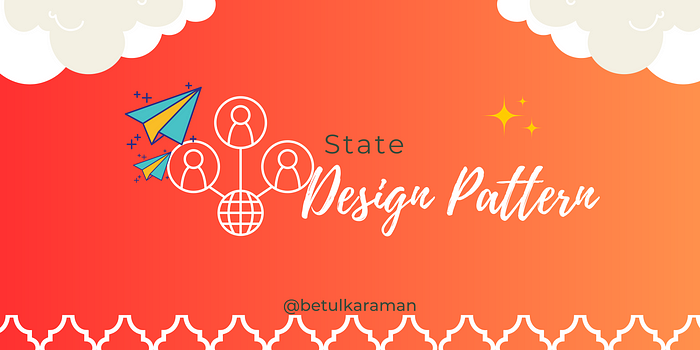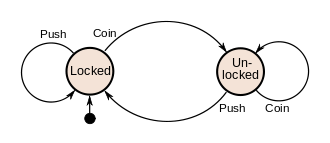State Management with State Design Pattern

In software development processes, various design patterns are employed to make complex systems more manageable and flexible. These patterns provide software engineers with more effective solutions to tackle problems, ensuring that the code is readable, sustainable, and extensible.
One of these patterns is the “State” pattern, which is based on the idea of representing object states with a series of separate objects. Thus, the behavior of an object can change as its state changes, while the object itself remains unchanged. The State pattern offers an effective way, especially for transitioning between states and managing these transitions effortlessly.
This article encompasses fundamental concepts, examples, and implementation guidelines to help you understand and apply the State pattern. Once you grasp how the State pattern works, you’ll possess a tool that facilitates writing more modular, maintainable, and extensible code in your software projects.
If you’re ready, let’s begin!
The State design pattern is a software design pattern used to represent the internal state of an object and alter its behavior based on this state. This pattern models different states of an object as separate objects, and as the object’s state changes, the corresponding object representing that state is replaced. Consequently, the object’s behavior can be dynamically altered based on its state.
The State pattern is particularly employed to manage transitions between states and represent the internal state of an object as a series of independent classes. This facilitates code to be more modular, readable, and easier to maintain.
The State pattern is closely related to the concept of a Finite-State Machine (FSM). How so? A Finite-State Machine, or FSM, is a mathematical model that represents the states in a system and the transitions between these states. FSM is defined by a set of states, a set of transitions, and an initial state. Each state represents a specific condition in the system, and transitions denote shifts from one state to another when a certain event or condition occurs in the system.

Finite State Machine (FSM), especially used to clearly model different states and transitions between them in a system. An FSM is utilized to understand, design, and analyze specific system behavior. The State design pattern assists in implementing this FSM concept because the object’s state and state changes are modeled with the State pattern, providing a structure similar to the fundamental principles of FSM.
Let’s consider a scenario where you have a class named Document in your software project. Each document can be in one of three different states: Draft, Moderation, and Published. With the State design pattern, we can create a Document class that can transition between these states and exhibit different behaviors in each state.
States and Behaviors:
Draft:
- In the Draft state, the document is not yet published.
- When the
publishmethod is called, it transitions the document to the Moderation state.
Moderation:
- In the Moderation state, the document can be made public, but only if the current user is an administrator.
- When the
publishmethod is called, if the user is an administrator, it transitions the document to the Published state.
Published:
- In the Published state, the document is immutable, and the
publishmethod does nothing.
Implementation of the State Design Pattern: To represent these states, we create individual classes for each state: Draft, Moderation, and Published. Each class represents a state of the Document and implements behaviors specific to that state. The Document class holds a reference to the current state, and its behaviors are determined based on this reference.
This design allows us to add behaviors specific to document states and tailor the publish method for each state. It makes our system more flexible and extensible.
public class Document {
private String state;
public Document() {
state = "draft";
}
public void publish() {
switch (state) {
case "draft":
moveToModeration();
break;
case "moderation":
approveForPublication();
break;
case "published":
break;
}
}
private void moveToModeration() {
state = "moderation";
System.out.println("Document moved to moderation status.");
}
private void approveForPublication() {
state = "published";
System.out.println("Document approved for publishable status.");
}
}The biggest weakness of a state machine built with conditionals becomes apparent as we add more and more states and state-dependent behaviors to the Document class. The content of most methods will consist of complex conditionals that select the appropriate behavior of a method based on the current state. Such code has a structure that is challenging to maintain because any change in the transition logic may require altering state conditions in every method.
The problem tends to grow larger as a project evolves. It is quite challenging to predict all possible states and transitions during the design stage. Therefore, a lean state machine built with a limited set of conditionals can evolve into a bloated mess over time.
Let’s take a look!
interface DocumentState {
void publish(Document document);
}
class DraftState implements DocumentState {
@Override
public void publish(Document document) {
System.out.println("Document moved to moderation status.");
document.setState(new ModerationState());
}
}
class ModerationState implements DocumentState {
@Override
public void publish(Document document) {
System.out.println("Document approved for publishable status.");
document.setState(new PublishedState());
}
}
class PublishedState implements DocumentState {
@Override
public void publish(Document document) {
System.out.println("The document has already been published.");
}
}
public class Document {
private DocumentState state;
public Document() {
this.state = new DraftState();
}
public void publish() {
state.publish(this);
}
public void setState(DocumentState state) {
this.state = state;
}
}This time, we created an interface called DocumentState to represent each state. Subsequently, we generated classes implementing each state (DraftState, ModerationState, PublishedState). We added a reference in the Document class to manage the state and designed the system by using the State Design Pattern when invoking the publish method to update the state. This allowed us to create classes for each state containing their specific behaviors, making the code more modular and easier to maintain.
Some of the advantages provided by the State Design Pattern are as follows:
1. Modularity and Ease of Maintenance: Classes representing each state encapsulate their specific behaviors. This allows us to handle each state separately and isolate state-specific code. Consequently, the code becomes more modular and easier to maintain.
2. Flexibility and Extensibility: Adding new states or modifying the behaviors of existing states is easier. To add a new state, you only need to create a new class and implement the interface. Similarly, modifying the behaviors of an existing state is done within the specific state class.
3. Prevention of Code Duplication: Since state transitions and state-dependent behaviors are encapsulated in separate classes, similar state transitions or behaviors can be reused. This results in less code duplication and cleaner code.
4. Ease of State Transition: Changing behaviors associated with a specific state or adding a transition to a new state is achievable by modifying or adding the class representing the relevant state. This facilitates ease of state transition.
5. Clearer Code Understanding: States and state-specific behaviors are clearly defined, making the code more understandable. Complex states and transitions are distinctly separated among classes.
The State Design Pattern, by offering these advantages, promotes a design that is modular, extensible, and easier to comprehend and maintain.
In this article, we explored the solutions that the State Design Pattern brings to the complexity of software development and state management.
This pattern suggests extracting state-specific codes into separate classes. By creating a class for each state and placing state-dependent behaviors within these classes, you can add new states or modify existing state behaviors by simply changing or adding the class representing the relevant state. This approach allows you to manage states independently and reduce maintenance costs.
With the State Pattern, state transitions can be controlled by both State classes and Context classes. In other words, a state change can be controlled not only by State classes but also by Context classes.
Wishing it contributes to your design and hoping it provides a new perspective for software development. Happy coding!
